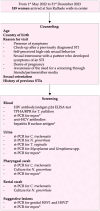Prevalence of Sexually Transmitted Infections Among Cisgender Women Coming to a Walk-In Center
- PMID: 40284941
- PMCID: PMC12031552
- DOI: 10.3390/v17040498
Prevalence of Sexually Transmitted Infections Among Cisgender Women Coming to a Walk-In Center
Abstract
The general female population is not considered a high-risk group for screening for sexually transmitted infections (STIs). This retrospective study describes the prevalence of Human Immunodeficiency Virus (HIV), Treponema pallidum (T. pallidum), Chlamydia trachomatis (C. trachomatis), Neisseria gonorrhoeae (N. gonorrhoeae), Trichomonas vaginalis (T. vaginalis), Mycoplasma spp., Ureaplasma spp., genital Herpes simplex virus (HSV), Monkeypox (mpox), Hepatitis B virus (HBV), and Hepatitis C virus (HCV) infections in asymptomatic and symptomatic cisgender women attending our walk-in STI clinic for the first time. Furthermore, it analyzes the number of individuals who returned for follow-up and were diagnosed with new STIs. Over 20 months, 189 women with a median age of 28.4 years were screened [129 (68.3%) asymptomatic and 60 (31.8%) symptomatic]. In order of prevalence, the most common STIs were: Ureaplasma spp. infections (50.3%), C. trachomatis (10.6%), N. gonorrhoeae (5.8%), Mycoplasma hominis infections (5.8%), T. pallidum (2.65%), HSV2 infections (2.65%), and mpox (0.53%). No diagnosis of HIV, trichomoniasis, HBV, or HCV was registered. After the initial evaluation, 128 (67.7%) women returned for follow-up, but only 43 (22.8%) repeated screening; among them, 11 (25.6%) were diagnosed with new STIs. Given the high prevalence of STIs in cisgender women, awareness measures to improve screening and prevention strategies in this neglected population are required.
Keywords: HIV; STIs; hepatitis; prevention; sexual health; women’s health.
Conflict of interest statement
We declare no competing interests related to this work. G.C. has no competing interests related to this work. T.C. has received personal fees for speaker panels from Gilead Sciences. S.D. has no competing interests related to this work. R.L has no competing interests related to this work. B.T. has no competing interests related to this work. M.R. has received personal fees for speaker panels from Tillots Pharma. E.B. has received personal fees for speaker panels from Gilead Sciences. P.C. has no competing interests related to this work. A.C. has received personal fees for advisory boards, speaker panels, and educational materials from Gilead Sciences, ViiV Healthcare, Janssen-Cilag, Merck Sharp & Dohme, and Theratechnologies. S.N. has received personal fees for advisory boards from Gilead Sciences and ViiV Healthcare, for speaker panels from Gilead Sciences, ViiV Healthcare, and Merck Sharp & Dohme, for meeting attendance from Gilead Sciences and Pfizer, and payments to her institution for consultancies from Gilead Sciences and ViiV Healthcare.
Figures
Similar articles
-
High rates of Treponema pallidum, Neisseria gonorrhoeae, Chlamydia trachomatis, or Trichomonas vaginalis co-infection in people with HIV: a systematic review and meta-analysis.Eur J Clin Microbiol Infect Dis. 2025 Jan;44(1):1-15. doi: 10.1007/s10096-024-04966-w. Epub 2024 Oct 28. Eur J Clin Microbiol Infect Dis. 2025. PMID: 39466544
-
High Burden of Symptomatic and Asymptomatic Sexually Transmitted Infections in a Routine Decentralised HIV Care Setting in Eswatini: A Cross-Sectional Study.Trop Med Int Health. 2025 Jul 22. doi: 10.1111/tmi.70011. Online ahead of print. Trop Med Int Health. 2025. PMID: 40695730
-
Population-based interventions for reducing sexually transmitted infections, including HIV infection.Cochrane Database Syst Rev. 2004;(2):CD001220. doi: 10.1002/14651858.CD001220.pub2. Cochrane Database Syst Rev. 2004. Update in: Cochrane Database Syst Rev. 2011 Mar 16;(3):CD001220. doi: 10.1002/14651858.CD001220.pub3. PMID: 15106156 Updated.
-
Population-based interventions for reducing sexually transmitted infections, including HIV infection.Cochrane Database Syst Rev. 2001;(2):CD001220. doi: 10.1002/14651858.CD001220. Cochrane Database Syst Rev. 2001. Update in: Cochrane Database Syst Rev. 2004;(2):CD001220. doi: 10.1002/14651858.CD001220.pub2. PMID: 11405980 Updated.
-
Sexually Transmitted Infection Prevalence, Partner Notification, and Human Immunodeficiency Virus Risk Perception in a Cohort of Women Completing Sexually Transmitted Infection Screening as Part of a Safer Conception Study.Sex Transm Dis. 2024 Jun 1;51(6):431-436. doi: 10.1097/OLQ.0000000000001951. Epub 2024 Feb 19. Sex Transm Dis. 2024. PMID: 38372541
References
-
- World Health Organization . Global Health Sector Strategies on, Respectively, HIV, Viral Hepatitis and Sexually Transmitted Infections for the Period 2022–2030. WHO; Geneva, Switzerland: 2022.
-
- European Centre for Disease Prevention and Control . A Systematic Review and Meta-Analysis of the Prevalence of Chlamydia, Gonorrhoea, Trichomoniasis and Syphilis in Europe. ECDC; Stockholm, Sweden: 2024.
-
- Salfa M.C., Ferri M., Suligoi B., Rete Sentinella dei Casi Clinici. Laboratori di Microbiologia clinica per le Infezioni Sessualmente Trasmesse Le Infezioni Sessualmente Trasmesse: Aggiornamento dei dati dei due Sistemi di Sorveglianza sentinella attivi in Italia al 31 dicembre 2021. Not. Ist. Super. Sanità. 2023;36:3–39.
-
- Catalano G., Diotallevi S., Lolatto R., Trentacapilli B., Ranzenigo M., Bruzzesi E., Castagna A., Nozza S. P-128 Prevalence of sexually transmitted infections in cisgender women coming to walk-in center. Sex. Transm. Infect. 2024;100:A223–A224. - PubMed
MeSH terms
LinkOut - more resources
Full Text Sources
Medical
Miscellaneous



